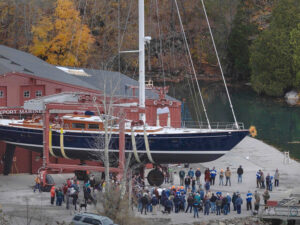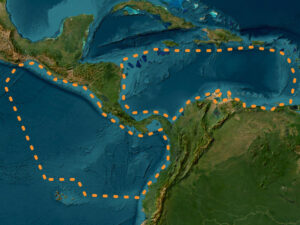Cruising as well as racing sailors should learn how to obtain maximum performance in any conditions, because knowing how to get the best out of your boat can enhance both safety and comfort–and its more fun to pass other boats than to be passed.
At the wheel, your body acts as a sensor; the boat, the water, and the wind seem to exist with you as one, and when sailing at top speed, a helmsman is focused on the task at hand and is in tune with the elements. Every crewmember should take a turn at the wheel because steering the boat will keep them interested and alert.
|
|
| |
|

|
| |
| Billy Black|
| |
|
|
| |
| Light-air sailing can be tedious, but it’s worth knowing how to keep your boat moving.* * *|
| |
|
|
| When sailing fast, boats are stable and maneuver easily. If the wind is brisk, theres plenty of incentive to hoist the sails. On too many days, however, when the winds are soft, its easy to get into the motoring trap. But light air has its benefits, if you work at it.
Look at a spell of light air as an opportunity to improve your sailing skills. Its hard to make heavy cruising boats perform, and getting maximum speed takes determination and an open mind, but once you build momentum, a heavy-displacement boat will sail nicely.
To squeeze the best light-air performance out of your boat, you first have to set her up right, then apply time-tested techniques when sailing.
Tuning the Boat
A combination of light displacement with good stability gives a boat its best performance. At least once a year when cruising, inventory everything on the boat and get rid of unneeded equipment. This will lighten the load and free up stowage space for what you do need. Where you stow objects is important. Tools, spare anchors, and other heavy gear should be stowed low and in the center of the boat.
Especially in light air, the key to good sailing performance is a clean bottom on your boat. Between the regular haulouts when you refresh your boats bottom paint, take every opportunity to remove accumulated slime or grass. If you have a folding or feathering propeller, make sure it functions properly.
Tune your mast by making sure its on the boats centerline, plumb, and has the recommended tension on the shrouds (see “Upright and Unwavering,” February 2000). Your sailmaker can help with these settings.
Tuning Your Skills
When I first take the helm, I like to stand up so I can see farther, feel the wind, and sense how the boat is performing, all of which are more difficult to do when sitting. Once you’re at top speed, then you can take a seat.
The rudder is like a brake. When you turn it, it creates drag, slowing the boat. Always turn the wheel slowly, and use as little movement as possible.
In light air, avoid the common mistake of sailing too close to the wind. In short, choppy waves, bear off to keep your speed up, but when you do so, remember to ease your sheets. Keep the boat on a steady, close-reaching course to accelerate to full speed. Be patient. On a boat thats light enough to respond, use crew weight to heel the boat to leeward. Take advantage of any smooth patch of water or puff of wind to accelerate.
Once you choose a course, trim your sails accordingly, then try to improve your speed by adjusting your sails. Your most important reference is the amount of pressure the rudder feeds back to you through the helm. If you have considerable weather helm, where the boat wants to round toward the wind, you should ease your sails out, move the jib lead aft, drop the mainsheet traveler to leeward, or take a reef. If you need speed, try easing the mainsails outhaul and halyard to give the sail more shape.
When making any significant course change, particularly a tack or a jibe, be sure the boat is sailing at full speed going into the maneuver. This will help you turn easier and accelerate back to full speed sooner. To ensure that Im going as fast as possible, I always wait for a stronger puff of wind before turning. Alert the crew in advance so they can prepare. If youre turning into the wind, trim your sails in. When bearing off, ease your sails out. The boat wont sail as fast, and it certainly wont sail faster, if you fail to adjust the sails to the new apparent-wind direction.
When sailing in light air, boats are sensitive to changes in trim, even those made by crew moving about. Quick movements by the crew can slow the boat down, and it can take a long time to get back up to top speed, so encourage everyone to move about the deck in a catlike motion.
Tuning the Sails
Sails work efficiently only when they’re trimmed correctly for the conditions.
The jib should luff evenly. If it luffs first at the top, move your jib-sheet lead forward. If the sail luffs first at the bottom, move your jib-sheet lead aft (see “How To Get Properly Twisted,” September 1998).
Make sure to ease the main boom topping lift so that its slack, then use the top batten as a guide to mainsail trim. It should be parallel to the boom. If it hooks to windward, ease the sail out (see “Sailing on Main Street,” February 1999) or loosen the vang.
If by moving crew weight you can heel the boat to leeward, it will help the sails take their proper shape.
Testing, Testing
Top-level crews spend days, even weeks, testing different sail-trim combinations. Experiment with all of your adjustments: boom vang, outhaul, halyard, sheets, even your steering. Make one adjustment at a time, and see if it improves boat speed. Observe your performance by watching your speedometer or GPS or by comparing your boat’s speed against that of other boats. When you notice an improvement, make a note of the adjustment you made to create it. So you can reproduce the settings, mark the halyards and sheets, and mark the deck at the optimum settings for your jib-sheet leads and the mainsheet traveler.
It never hurts to get expert advice, so consider inviting a champion racing sailor with you for a daysail. Have him or her critique your trim and sailing technique and give you pointers on how to get the best out of your boat.
If the skipper enjoys the challenge of making the boat perform and gets the crew involved, everyone will have a good time. You can make a game of it. For example, using GPS to measure distance traveled, you can time how long it takes to sail a mile. Then try to beat your time over the next mile. On passage, set a competition for the most miles sailed over the course of a watch.
Eventually, though, all of us have a point beyond which the reward of slow forward progress isnt worth the effort. I usually call it quits when the boats speed is consistently below 3 knots.
Gary Jobson–author, TV commentator, and a Cruising World editor at large–was tactician aboard Courageous when she won the Americas Cup in 1977.








